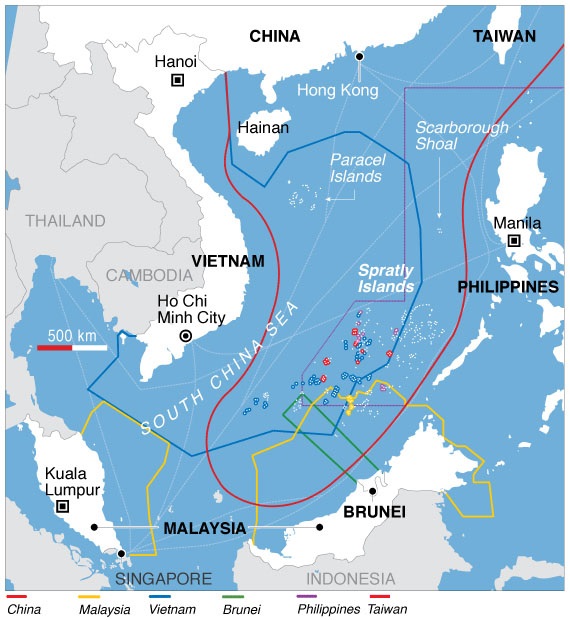
So, China has 2 carriers, 36 destroyers, 52 frigates and 67 subs (SSN and SSK) to enforce it’s claims to the South China sea. All the nations that have competing claims (Taiwan, Philippines, Indonesia, Brunei, Malaysia and Vietnam) have a total of 4 destroyers, 43 frigates and 17 subs (SSK). This is not an even match. But, there are a few other players in the immediate region and there are a few other players in the Pacific that may have some influence. Lets look at them:
Also in the area are the following countries:
…………………….Singapore…..Thailand…..Cambodia
Small carrier………………………….1
Destroyers……….0
Frigates……………6………………..7
Corvettes…………6…………………7
Littoral……………..8
Submarines……..4………………….1
Patrol vessels…..2………………….8
Patrol ships…………………………22……………..21
Patrol boats…………………………23
LPD………………..4………………..1
LST……………………………………2
LCU…………………………………..9………………1
Mine Sweeper…..4………………….5
Others……………3………………….5
Auxilleries…………………………..17
Riverine Patrol Boats…………….189
Not connected to the South China Sea, but close enough to get our attention are the following:
………………………….S. Korea……N. Korea…..Japan…..Australia….New Zealand
Helicopter carriers……1……………………………….4……………2
Cruisers…………………………………………………..8
Destroyers…………….12………………………………22…………..2
Frigates………………..11…………….3………………10…………..8…………….2
Corvettes……………..12…………….14………………6
Submarines…………..18…………….70……………..20…………..6
Patrol vessels………….0……………………………………………………………..2
Patrol ships…………..71……………………………….13………………………….2
Missiles boats…………………………30
Torpedo boats……………………….247
Patrol boats…………………………..191……………….6…………..2
LSD……………………………………………………………………….1
LST……………………..8…………………………………3
Other Amphib………….5………………………………..2………………………….1
Mine warfare………….11……………30………………26…………..6
Other……………………2………………………………..8…………..7…………….1
Auxiliary……………….20……………………………….21………….2
Needless to say, in an extreme emergency (which would probably involve the U.S.) we would probably expect Japan, Australia, South Korea and Taiwan to cooperate. This is a total of 7 carriers, 8 cruisers, 40 destroyers, 51 frigates and 48 submarines compared to China’s 2 carriers, 36 destroyers, 52 frigates and 67 subs (SSN and SSK)
Finally there is the Russian Navy, which has 1 carrier, 2 battle cruisers, 11 destroyers, 10 frigates and around 45 submarines (SSGN, SSN and SSK), although not all will be in the Pacific. Then there is the United States which has 11 carriers, 9 amphibious carriers, 22 cruisers, 69 destroyers, 20 Littoral Combat Ships and 52 submarines (SSGN and SSN). Not all of these will be it the Pacific either. Details are here:

If it were available, which I’m sure it isn’t publicly, it’d be useful to compare readiness and training levels, because some of those navies might be like the Ukrainian army of 2014, lots of tanks but unable to effectively use them.
There is certainly some open source material on the readiness of the ships. This is an issue with the Russian fleet. As for the readiness of the naval forces and their training, morale, motivation, and capabilities, this would take some poking around to get a feel for, and it would be difficult to get something definitive on this. Needless to say, some navies are manned by volunteers and some by draftees. There are also differences in recruit quality, training and compensation. How this all translates into combat effectiveness is hard to determine. We have not done any such evaluation for naval forces.
[…] And: Size of Fleets around the South China Sea, Part 2 | Mystics & Statistics (dupuyinstitute.org) […]